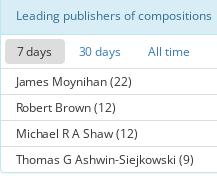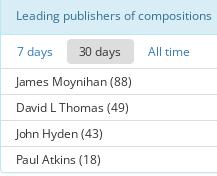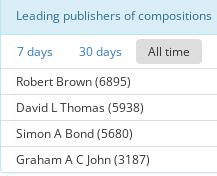


| Home page | Bellringing | Talks & lectures | Fell walking | Settle - Carlisle | Metal sculpture | Brickwork | Journeys | Ergonomics | The rest | Site map |
When talking and writing about ringing I have often emphasised that it is a many faceted activity. As well as being a physical and mental skill it intersects with other areas of expertise, including technology, history, music and maths. So as well the challenge and satisfaction of performance, ringers can find interest from exploring other aspects.
One example is composition. We all know that bobs and singles can produce touches, and that if you need to call a quarter or a peal there are plenty of compositions to choose from, but have you ever thought about who produced the compositions, or how or why?
Ringers have been devising compositions for centuries, even before the separate concepts of a plain course and call emerged. In the early days ringing was mainly on lower numbers of bells and their aim was simply to produce true extents (what they called ‘complete peals’) ie to ring every row just once. As ringing on higher numbers became increasingly common completeness became an unrealistic target (a standard peal of Major uses an eighth of the available rows and on twelve it’s around one in 10,000), which enabled composers to be more selective.
A lot of modern composers strive to include the more musical rows in their work. But that sometimes leads to complicated compositions that are more difficult to call.
Some composers aim for simplicity, where the pattern of calls is simpler and well structured, making it easier for less experienced conductors to learn, remember and check that things are still on track while ringing.
A few composers aim for specific lengths, with date touches being the most obvious example. Matching the length to the year means each year needs a new crop of compositions. Whatever the composer’s aim, the need for truth (ie no repetitions) is so engrained in the ringing ethos that it is needed for all but simple training touches.
I first composed in my youth when I was running an active band keen to do something new. That was for a 1964 date touch, and in fact all my compositions have been date touches, either because none were published when we needed them or in recent years when they are published because I needed something simpler for the band that would be ringing.
When I started the only tools available were pencil and paper, and the compositions were only published on paper but now it’s very different. Several aids and proving tools are available but I suspect most composers start to work out their ideas on paper. The big change in recent years is CompLib, which does for compositions what BellBoard does for performances. So ringers can publish their work and they can also search to see what others have done.
On the home page CompLib has a ‘leading publishers’ display, and I recently spotted that one of the Branch’s keen young ringers was at the top of the list. I’ve watched James’ progress as a ringer and more recently a conductor, and I am delighted to see him trying his hand at composition – and with more vigour than I ever did. I only composed when I needed something to ring whereas James has explored much more widely what is possible.
When I looked there were 92 compositions ranging from Minor up to Sixteen, half of which were Major. Most of them were quarters or peals, with a few long lengths, the longest being 35,420 Grandsire Cinques.
Needless to say, the first time James conducted a quarter of Surprise Major he called his own composition.



Article originally printed in the Winter 2024 Sonning Deanery Branch Newsletter,
John Harrison, Febuary 2024
| Back to top | Back to Articles | Back to What's New | Return to Home page |